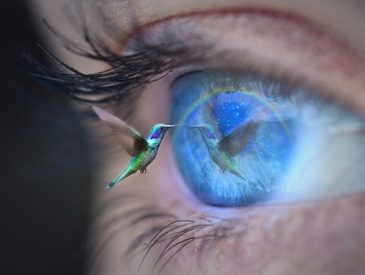Whether or not there is anything in your eye, feeling like something is in your eye can be extremely annoying. In addition, it can occasionally be accompanied by tearing, pain, and irritation. To find out what it might be and how to get relief, continue reading.
If a person can feel something in their eye, it is typically an eyelash, some dust, or a grain of sand. However, “foreign body sensation” can cause eye discomfort without there actually being anything in the eye.
Please read on.
Table of Contents
Why Does It Feel Like Something’s in My Eye?
Corneal Injury
Any injury that affects the cornea is considered a corneal injury. This is the transparent dome that covers the colored portion of the eye.
A corneal laceration (cut) or corneal abrasion (scratch) may result in injuries.
Although vigorous rubbing or poking the eye can result in a corneal abrasion, the most common cause is a foreign object under the upper eyelid.
In particular when wearing contact lenses, lacerations are more serious and may result from being struck in the eye with a sharp object.
You might experience the feeling that something is in your eye if your cornea is damaged. Other symptoms can include:
- Headache
- Blurred vision
- Loss of vision
- Tearing
- Redness
- Pain
- Find Relief
Minor wounds frequently recover on their own in a few days. Artificial tears can make your eyes more comfortable and lubricate them better. For relief, you could apply cold compresses to the closed eyelid several times each day.
Consult your eye doctor for the appropriate treatments if you suspect you may have a corneal injury.
Corneal Ulcer
You have an open sore on your cornea if you have a corneal ulcer. Numerous factors, including bacterial, viral, and fungal infections, can result in an ulcer.
When you blink, the ulcer may make you feel like something is stuck in your eye.
You may also have:
- A white spot on the cornea
- Swelling
- Pus or discharge
- Blurred vision
- Tearing
- Extreme pain
- Redness
- Light sensitivity
If you wear contacts or have another viral infection, such as herpes, shingles, or chicken pox, your risk of developing corneal ulcers rises.
- Find Relief
Corneal ulcers can be caused by a variety of factors, and they need to be treated right away. You could harm your eye if you don’t. Depending on the underlying cause, your ophthalmologist may advise antiviral, antifungal, or antibacterial eye drops. Also available for pain relief are drops that enlarge the pupil.
Laceration
A corneal cut characterizes a laceration. The cornea may be lacerated completely or partially by the cut.
- Treatment
According to the AAO, a corneal laceration is serious, and to prevent loss of vision, a person should seek immediate medical attention.
If there is a laceration, the eye should be shielded, ideally with the bottom of a plastic cup. They should then visit an ophthalmologist.
A person should avoid:
- rinsing the eye with water
- removing any foreign objects
- applying pressure to the eye
- taking medication such as aspirin or ibuprofen, as these can thin the blood and cause more bleeding
Ulcer
An ulcer is a corneal open sore. Bacterial, viral, parasitic, or fungal infections as well as extreme dry eyes can cause ulcers to form.
Some signs and symptoms of a corneal ulcer may include:
- redness
- severe pain and soreness
- the feeling of having something in the eye
- tearing
- pus or discharge
- blurred vision
- sensitivity to light
- swelling of the eyelids
- a white spot on the cornea
Treatment
Antifungal, antibiotic, or antiviral eye drops may be recommended by an ophthalmologist or optometrist to treat the infection.
When the infection has cleared up, they might recommend steroid or anti-inflammatory eye drops to avoid scarring. It’s crucial to carefully follow the dosing guidelines for steroid eye drops.
Another option might be surgical intervention. If the ulcer has significantly scarred the cornea or if the patient loses vision, a corneal transplant may be required.
Fungal Keratitis
Fungal keratitis is an infection of the cornea. Use of contact lenses or eye trauma can lead to the development of fungus keratitis. Different fungi can cause fungal keratitis, including Fusarium, Aspergillus, and Candida.
It’s possible for people with fungal keratitis to experience eye pain.
Other symptoms may include:
- pain
- redness
- blurred vision
- sensitivity to light
- excessive tearing
- discharge
To determine the type of bacteria causing the infection, an ophthalmologist may scrape a sample of the lesion from the cornea.
- Treatment
Treatment options for fungal keratitis may include antifungal medications such as natamycin, amphotericin B, or voriconazole for several monthsTrusted Source.
There may be a need for a corneal transplant if the infection does not get better.

Eye Herpes
Eye herpes is an infection of the eye brought on by the herpes simplex virus (HSV), also known as ocular herpes. Depending on how far the infection penetrates the layers of the cornea, there are various types of eye herpes.
The most typical type of keratitis, epithelial keratitis, affects your cornea and may give you the impression that something is in your eye.
Other symptoms include:
- eye pain
- redness
- inflammation
- tearing
- Discharge
- Get relief
You should see your doctor if you suspect that you have eye herpes. It’s possible that you’ll need steroid eye drops or antiviral medication.
Following the recommended course of treatment is crucial because, if untreated, eye herpes can permanently harm your eyes.
Sjogren’s Syndrome
Sjogren’s syndrome is an autoimmune condition. The tear and saliva glands are attacked and injured by immune cells, which causes it to develop.
According to the National Institute of Neurological Disorders and Stroke, it affects around 1–4 million peopleUsually over 40 years old, Trusted Source in the United States. Sjogren’s syndrome tends to strike women more frequently.
Due to the body’s inability to produce enough saliva or tears, the two main symptoms are dry eyes and dry mouth.
Some other symptoms affecting the eyes and mouth may include:
- itching and burning eyes
- a sensation similar to that of sand being in the eyes
- blurred vision
- sensitivity to light
- difficulty swallowing
- a chalky feeling in the mouth
Also possible are corneal ulcers and oral thrush.
The joints, lungs, digestive system, nerves, and blood vessels can all be impacted by Sjogren’s syndrome. As a result, other symptoms may include:
- swollen glands
- rashes
- dry skin
- joint pain
- chronic dry cough
- numbness in the fingers and toes
- fatigue
- vaginal dryness
Treatment
Using artificial tears all day is part of the Sjogren’s syndrome treatment. An individual may use a gel at night. The other option is prescription eye drops.
To help protect the eyes and stop tears from evaporating when outside, a person can put on sunglasses or goggles.
Punctal occlusion may be helpful if the condition is more serious. For this procedure, a doctor of optometry must insert tiny plugs to block the tear ducts. This may encourage tears to linger longer, keeping the eyes moist.
Dryness
A common issue is dry eyes. It occurs when your tears are insufficient to keep the surface of your eye moist.
Tears are continuously left on the surface of your eye when you blink. You can maintain your vision and eye health in this way. Dry eyes occur when this thin film malfunctions, though, on occasion.
You might experience excessive tearing that is followed by dry spells if you have dry eye, which can make you feel like there is something in your eye.
Other symptoms include:
- scratchiness
- stinging or burning
- redness
- pain
As you get older, dry eyes are more prevalent. The National Eye Institute states that women are more likely to be affected than men.
Many things can cause dry eyes, including:
- certain medications, such as antihistamines, decongestants, and birth control pills
- seasonal allergies
- medical conditions, such as thyroid disorders and diabetes
- wind, smoke, or dry air
- periods of insufficient blinking, such as staring at a screen
Blepharitis
An eyelid’s inflammation is referred to as blepharitis. The lash line on both eyelids is typically affected. It is brought on by blocked oil glands.
In addition to the sensation that there’s something in your eye, blepharitis can also cause:
- a gritty sensation in your eyes
- burning or stinging
- redness
- tearing
- itching
- skin flaking
- eyelids that appear greasy
- crusting
- Get relief
To help the clogged gland drain, keep the area clean and regularly apply a warm compress to the affected area.
Make an appointment with your healthcare provider if, after a few days, your symptoms don’t appear to be getting better. Antibiotic or steroid eye drops might be required.
Conjunctivitis
Pink eye is referred to medically as conjunctivitis. Conjunctivitis is an inflammation of the tissue that lines the inside of your eyelids and covers the white of your eye. Particularly in children, the condition is very prevalent.
Conjunctivitis’ inflammatory effects can give the impression that something is in your eye.
Other conjunctivitis symptoms include:
- a gritty sensation
- redness
- itching
- burning or stinging
- excessive watering
- discharge
- Get relief
Apply a cool compress or a damp, cool towel to your closed eye if you are experiencing conjunctivitis symptoms.
A bacterial infection that is contagious frequently causes conjunctivitis. In order to get antibiotics, you’ll probably need to follow up with your doctor.
Chalazia Or Stye
A chalazion is a tiny, painless lump that forms on your eyelid. A blocked oil gland is the root cause of it. One chalazion may appear or several chalazia may develop simultaneously.
A chalazion and an external or internal stye are frequently misunderstood terms. An infection of the sweat gland and eyelash follicle is known as an external stye. an oil gland infection that has an internal stye. Styes typically cause pain, unlike chalazia, which are painless.
Chalazia and styes both have the potential to enlarge the eyelid’s edge or leave a lump there. The sensation of having something in your eye can be caused by blinking.
- Get relief
Styes and chalazia typically go away on their own after a few days. Apply a warm compress to your eye to help the area drain while you recover. An antibiotic or surgical drainage may be required to treat a stye or chalazion that doesn’t rupture on its own.
Pinguecula and Pterygium
The conjunctiva grows yellowish growths as a result of pinguecula. Eye doctors typically find this condition on the side of the eye closest to the nose.
Those who have pterygium, also known as surfer’s eye, have fleshy growths on their conjunctiva that might have started as pingueculas. A pterygium can remain small, but if it expands, it could impair someone’s vision.
According to ophthalmologists, exposure to UV light, wind, and dust causes pinguecula and pterygium to form.
- Treatment
Despite the fact that surgeons can remove these growths, they might reappear. Artificial tears and other eye protection measures like wrap-around sunglasses can aid in preventing regrowth.
Foreign Body
Even though you can’t see it, there’s always a chance that something is actually stuck in your eye. Some of the debris flecks have a size of 0.3mm to 0.1mm or less. The feeling of a foreign body in this instance is real.
You could try to remove the foreign bodies by:
- Flushing the foreign body out of the lower lid with artificial tears or saline solution while holding the eyelid open
- Using damp cotton swabs to gently tap on the foreign body in the eye
You should visit an eye doctor if those methods are ineffective. They could safely remove the foreign object from the eyelid or assist you in figuring out what’s causing the discomfort.
Read about Why Do My Eyes Water When I Yawn?
What Does It Mean When You Feel Something in Your Eye, But Nothing’s There?
When you have no foreign object in your eye but feel as though there is, this is referred to as the foreign body sensation. There might be a stray eyelash there, or you might constantly have dry eyes. You may occasionally experience irritation of the eyelid due to your contact lenses.
Foreign body sensation typically results in eye pain and inflammation, which makes you wonder if there’s a health problem.
How Do You Get Rid of a Foreign Body Sensation in Your Eye?
Visit an eye doctor or other healthcare provider as soon as possible to help eliminate the foreign body sensation. They can actually remove anything that may be in the eye to make you feel better.
If nothing is found, they might diagnose you with an issue that is easily treatable with improved eyelid hygiene.
It might not be necessary to remove the cause of the sensation of a foreign body.
For instance, you might have an eye scratch from a contact lens, unfocused eyelashes, or eyeball irritation from your living or working environment.
By inspecting your head, eye, and other areas around the eyes, your doctor can usually assist with a diagnosis. They might discover that their main worry is irritability as a result.
Eye drops and other treatments may be prescribed to you in order to make you feel better.
What Are the Symptoms of Something in Your Eye?
There are many signs that something is in your eye. These can include:
- Pain when looking at light
- Bloodshot eyes
- Excessive blinking
- Extreme tearing
- Dry eye
- Feeling of discomfort or pressure
- The sensation that something is there
- Burning
One symptom might be present or several. It doesn’t necessarily mean that your health is negatively impacted, though. It merely suggests that you might require a diagnosis from an eye specialist.
Why Do I Feel Like There is a Worm in My Eye?
There could be many reasons why some people feel as though they have a worm in their eye. One of the most delicate organs in our bodies is the eye. As you blink, it’s possible that eyelashes entered the eye and began to move there.
Unfortunately, you might actually have a worm infestation if you feel like there are bugs crawling on your eyes. On the surface of the eye, tiny worms can crawl.
Loiasis refers to itchy, non-painful swellings of the body that can appear anywhere. They might then develop into eye worms, and you might also have them under your skin.
Since this is a parasitic infection, getting rid of the worm is unlikely to make it go away. To eradicate the parasites in your body, you need a special medication.
When to See a Doctor?
To prevent vision loss, a person suffering from a corneal laceration or ulcer needs to see a doctor right away.
Anyone who suspects they have a foreign object in their eye should visit an eye doctor for a thorough eye exam. If a person cannot recognize a foreign object that might be irritating their eyes, they should also visit an eye doctor.
A person should see an eye doctor for further evaluation if treatment for a foreign body sensation is ineffective.
A person should visit an eye doctor if artificial tears are not sufficient to lubricate the eyes. To stop the development of advanced dry eyes, they can suggest additional therapies and follow-up appointments. People with advanced dry eyes might eventually experience vision loss.
A medical condition or specific medication may be the cause of dry eyes, which can also be diagnosed by a doctor who can also recommend various treatment options.
A doctor should be consulted by anyone who has an eye infection to determine whether or not they require antibiotic treatment.
Consult an ophthalmologist or optometrist if you experience persistent eye pain, vision loss, significant discharge, conjunctival scarring, or if you frequently feel like something is in your eye.
Summary
For a variety of different reasons, a person may feel as though there is something in their eye. Others might not, while some might involve actual foreign objects.
Two conditions that can cause someone to feel as though something is in their eye are dry eyes and conjunctivitis. This symptom may be relieved by over-the-counter artificial tears. There may be other infections and eye injuries that need immediate medical attention.
To avoid long-term harm and vision loss, anyone who suspects they have an infection or eye injury should see an eye doctor.





